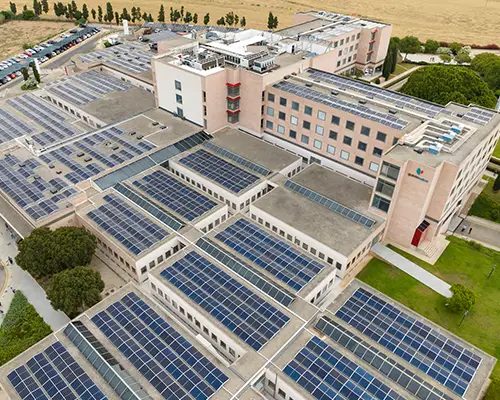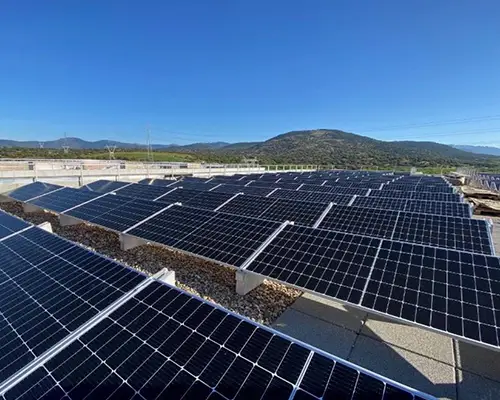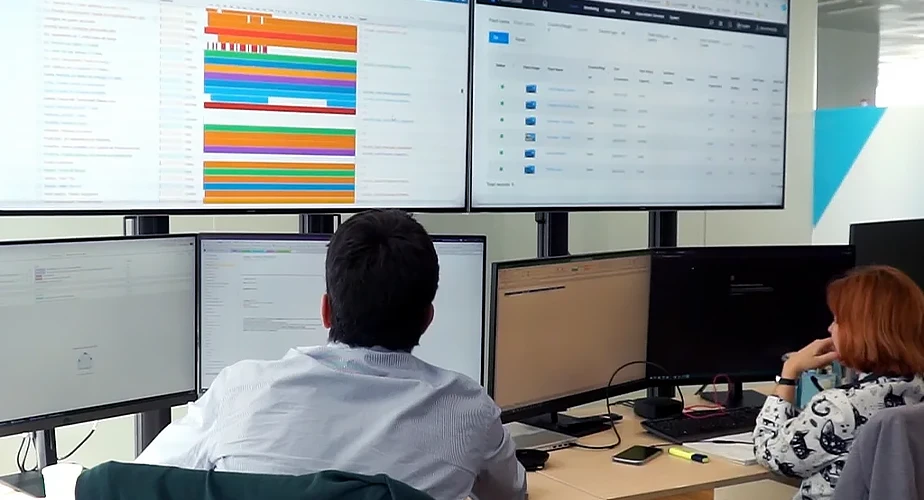Energy efficiency, secure supply, renewable energies
Heat waves, flooding, and the associated effects are already impacting our day-to-day lives. As a company operating on the global stage, it is imperative for us to play a role in limiting the consequences of the climate crisis. The management supports a team of experts working intensively to implement our Group-wide climate target. By 2040, Fresenius is planning to achieve climate neutrality in Scopes 1 and 2 primarily through implementing reduction measures. The intention is to offset any remaining greenhouse gas emissions.
Group climate targets
- Intermediate target: Reduction of the entire Scope 1 and Scope 2 emissions by 50% in absolute terms by 2030 (base year: 2020)
- Climate neutrality in Scopes 1 and 2 by 2040
- Net zero by 2050
Scope 1 includes direct emissions that we cause through our own business activities. Scope 2 relates to indirect, energy-related emissions; they are therefore incurred through the consumption of purchased energy. Scope 3 relates to other indirect emissions from our value chain.
Our position on climate protection
Primarily as a result of increased use of renewable energies and efficiency measures, we succeeded in reducing our absolute Scope 1 and Scope 2 emissions in 2023 by 22% in comparison with the base year 2020.
Scope 1 and Scope 2 Emissions from 2020 to 2023
(in t CO2 equivalents in thou.)1
In 2023, Fresenius caused a total of 531 thousand t CO2 equivalents (2022: 641 thousand t CO2e). This is approximately as much as 50,500 people in Germany cause together each year1 – in other words approximately the amount generated by a medium-sized town. This number clearly highlights our responsibility for climate protection – and simultaneously demonstrates the magnitude of the lever we possess in order to make a contribution by means of climate protection measures.
- The Scope 1 emissions amounted to 308 thousand t CO2e. In comparison with the previous year, we succeeded in reducing these emissions by 2% (2022: 315 thousand t CO2e).
- The market-based Scope 2 emissions were reduced by around 32%, from 326 thousand t CO2e in 2022 to 223 thousand t CO2e in 2023. Among other things, this reduction reflects the increased proportion of electricity generated from renewable resources.
Scope 3 emissions cover all upstream and downstream activities along our value chain. 2023 marks the first year we are disclosing our Group-wide Scope 3 emissions in accordance with the Greenhouse Gas Protocol Scope 3 Accounting and Reporting Standard.
After closely examining all 15 Scope 3 emission categories, we have identified ten categories as relevant. The remaining categories are not reported as they are either already covered in Scopes 1 and 2 or are not applicable to our business model.
In 2023, our Scope 3 emissions totaled 3,662 thousand t CO2e. Purchased goods and services account for the majority of our Scope 3 emissions with 40%.
We are continuously striving to improve the transparency of our Scope 3 emissions and are aiming to reduce the impact of our value chain by setting ambitious reduction targets.
Scope 3 emissions 2023
(in t CO2 equivalents in thou.)1
Reducing energy consumption and guaranteeing secure supply
The reduction of energy consumption is a key factor for being in a position to reduce greenhouse gas emissions. However, this is a challenging task for us as a healthcare company. On the one hand, we would like to reduce energy consumption as much as possible. On the other hand, we have to guarantee the safety of patients in our facilities at all times and ensure robust energy supply for our production. A special backup system ensures an uninterrupted supply of electricity for our hospitals.
Security backup for power supply 24/7
All our German and Spanish hospitals have a backup power system on standby to ensure an uninterruptible energy supply at all times. It ensures that important equipment and systems remain operational if there is a power outage, and thereby guarantees that a supply of electricity is available for patients at all times.
In 2023, Fresenius consumed a total of 3.09 million MWh of energy, a decrease of 3% compared to the previous year (2022: 3.18 million MWh). The reduced consumption is due in part to targeted energy efficiency measures.
Smart energy management
A key factor in our hospitals is to use energy efficiently. Air conditioning systems are increasingly being used not only in our Spanish hospitals, but also in our German clinics. These systems regulate the room temperature and help to keep the air clean with bacterial filters. Both of these aspects are vitally important for the hospital stay of our patients. However, the complex cooling process means that they use a great deal of electricity. For example, at Quirónsalud the air conditioning systems are responsible for a large proportion of the total energy consumption. Since 2011, we have been working on automating the management of these devices: When the outside temperatures drop, the systems adjust their output automatically. This allows us to better adapt to increasingly frequent abrupt and extreme temperature changes, while simultaneously saving energy.
We are also committed to the implementation of smart energy management, for example through central portals that allow us to control various energy parameters, ranging from the price of electricity on the energy market to individual energy consumption at our different sites. For example, in our German hospitals, we are able to make use of a central energy procurement and management system to compare various consumption values, strategically introduce improvement measures, and share best practices from different hospitals.
We are gradually upgrading our infrastructure. At production sites, we use metrics for this, such as the performance of devices and systems that consume a lot of energy. We then compare the values with those of more energy-efficient systems, and ultimately take a decision on whether or not to convert them. This approach allows efficient and cost-effective solutions to be deployed – e.g. LED lamps or heating, ventilation and air conditioning systems (HVAC).
Fresenius also invests in new buildings and modernizations that meet the latest energy standards and the relevant statutory legislation.
Expansion of renewable energies
In 2023, we purchased around 551,260 MWh of electricity from renewable sources Group-wide such as hydro, solar, or wind power. This is roughly equivalent to the annual output generated by 37 advanced wind turbines operating under good conditions.2 Overall, we were able to increase the proportion of electricity consumed from renewable sources Group-wide from around 12% (2022) to around 18% in 2023. Since 2022, our hospitals in Germany have been supplied with 100% certificated green electricity. For the first time in 2023, Fresenius Kabi purchased electricity generated from renewable energies for seven production facilities.


Aside from the purchase of electricity from renewable energy sources, we are generating our own electricity at an increasing number of sites. This enables us to use renewable energies independently of external electricity utilities.
Fresenius Kabi uses three solar plants to generate
4,883
MWh each yearfor the manufacture of MedTech products.
Quirónsalud already operates photovoltaic plants at
19
out of50
of its Spanish hospitals.
1The calculation is based on the values of the Federal Ministry for Environment, Nature Conservation and Nuclear Safety and Consumer Protection (German language only).
2The calculation is based on the data of the energy utility EnBW (German language only).




